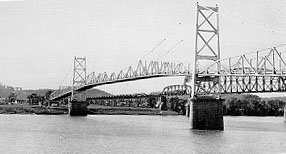Each month, we feature an Ohio Legacy City on our #GOPCThread Series, #OHCommunitySpotlight. This month, we are visiting the City of the Gauls along the banks of the Ohio River - Gallipolis
This month, GOPC’s #OHCommunitySpotlight features Gallipolis! Nestled in southeastern Ohio, Gallipolis rests on the Ohio River.
Gallipolis – pronounced Gal ′ – a – po – lees ′ - is the county seat of Gallia County. The city’s name is coined from Latin, with “galli” named after the French Gaul and “polis” named for “city” in Greek. It is familiarly known as “The Old French Settlement.”
Before the arrival of European settlers, the area around Gallipolis was populated by members of the Shawnee Tribe of the Hopewell Culture
Hopewell Culture National Historical Park (Image via U.S. National Park Service)
In the late 1700s, Gallipolis became a speculation project of the Scioto Company, which encouraged French investors to purchase land in Ohio. Ultimately, the French investors found their investment worthless.
The proposed purchase by the Scioto Company is shown in red. The proposed purchase by the Ohio Company is in blue. The final purchase by the Ohio Company is in green. The French Grant is orange.
A petition to Congress and President Washington for aid resulted in the Ohio Company sending Woodsmen from Marietta to build a settlement. The investors shaped the area into a thriving river trade community.
During the American Civil War, Gallipolis’ location helped the city experience an economic boom, as troops traveled through the city, warehouses were built, and river traffic increased.
Tragedy struck Gallipolis on December 15, 1967 when the Silver Bridge, an eyebar-chain suspension bridge built in 1928 over the Ohio River connecting the city with Point Pleasant, WV collapsed under the weight of rush-hour traffic, resulting in the deaths of 46 people.
In The Mothman Prophecies (1975) author John Keel linked the Silver Bridge collapse to alleged sightings of the Mothman. The story was adapted as a film by the same name, released in 2002.
Today, Gallipolis has a population around 3,300. Its proximity to the river and neighboring West Virginia still makes Gallipolis a prominent shipping center for farming and coal-mining.
Top employment in Gallia County includes healthcare, educational services, and retail trade.
Just north of the city, The University of Rio Grande and Rio Grande Community College provide Gallia County with both private and public higher education opportunities.
True to this day, Gallipolis recognizes its French heritage. Each May, the city commemorates the 1825 visit by General Marquis de Lafayette, a French General who aided in the Americans during the American Revolution.
The oath of Lafayette at the Fête de la Fédération, 14 July 1790; French School, 18th century at Musée de la Révolution française
Our House Tavern, the tavern and inn that hosted General Lafayette, serves as a historical museum in Gallipolis.
An abundance of riverfront recreation provides 30 miles of river access to Gallia County, with a boat launch along Gallipolis’ Downtown Historical and Garden Lots District.
Rich in community pride, Gallipolis was recognized by The TODAY show for the city’s “Gallipolis in Lights,” a volunteer-led initiative to decorate the city park in holiday themed music, lights, and decorations. The TODAY show coined Gallipolis one of “America’s Merriest Main Streets.”












